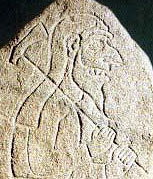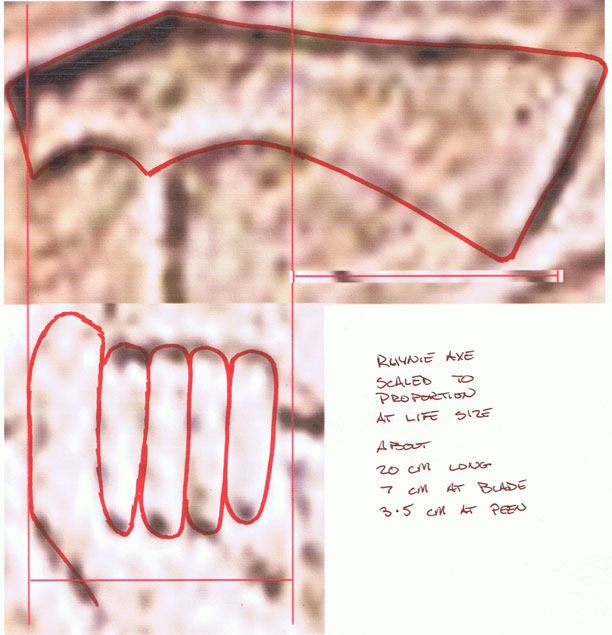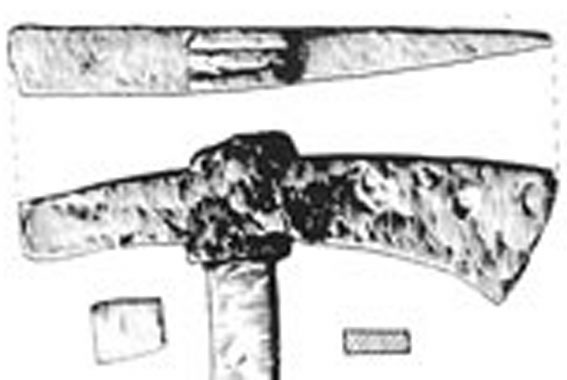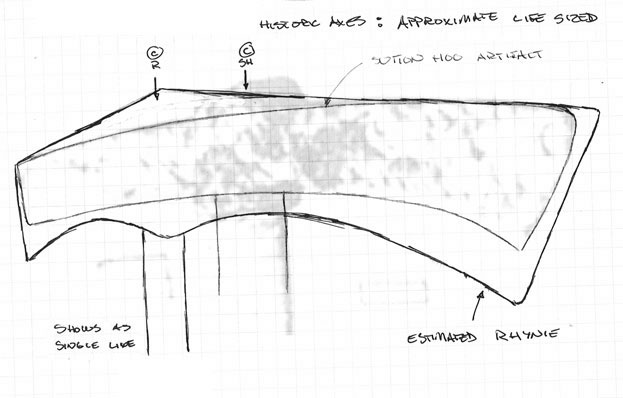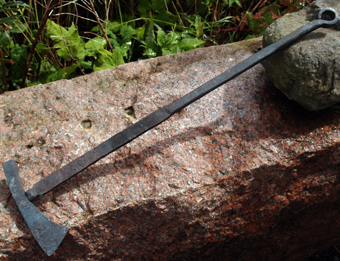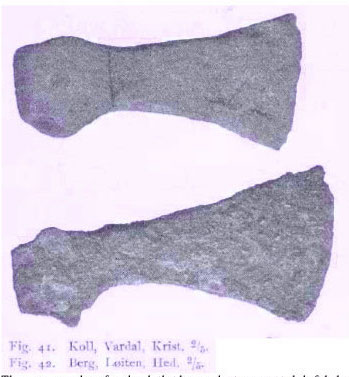This article is broken out from the more complete description of the
entire Turf to Tools project also available currently on this web
site, done primarily to provide an addition to the paper ‘Experiment
Archaeology & Art – the Turf to Tools Project’ currently pending
book publication.
For details on the individual iron smelts and the bloom to bar
phase, see the complete report on the Turf to Tools Project on this
web site : www.warehamforge.ca/ironsmelting/turf2tools/index.html
There is a separate photo essay illustrating the physical process of
constructing the axe from the starting blooms : www.warehamforge.ca/ironsmelting/turf2tools/bloom-bar-axe.html
Note that the numbers for images, footnotes, image credits have been
modified on this version.
Introduction : Turf to Tools
The Turf to Tools project (T2T) was undertaken primarily at the
Scottish Sculpture Workshop in Lumsden, Aberdeenshire, Scotland,
with additional work at the Wareham Forge, Ontario, Canada. The
project was initially conceived as "... an ongoing investigation in
to landscape, material and craft, inspired by local archeological
investigations in Rhynie, Aberdeenshire." (UN, 2016)
As an undertaking, T2T would be comprised of three primary working
sessions, the rough working plan was for Phase 1 (2014) to centre on
iron smelting, Phase 2 (2016) to include bloom to bar, and Phase 3
(2023) to include bar to object, with a total of eight individual
iron smelts.
Inspiration : The Rhynie Man Axe
In 1978 a large stone slab was uncovered just south of Rhynie. The
enigmatic figure carved in one surface, dubbed the Rhynie Man, would
channel the 'object' part of the project. The cartoon like figure,
likely created some time about 400 - 600 AD, holds over his shoulder
an axe. Who is depicted? What is the reason for his looming
presence? What is the original reason for the figure’s exaggerated
details : pointed teeth, big hooked nose, long hair or head-dress?
(appendix B, Rhynie as Bogie : www.warehamforge.ca/ironsmelting/turf2tools/bogie.html)
What are the construction details and use purpose of that axe? The
axe would become the goal of the extended process of ore to bloom to
bar to object. To make determining the details all the more
difficult, research suggested no artifact axes have been found in
Scotland for the period of reference. Within all of Great Britain,
only a mere handful have been found overall. Searching for a
possible artifact prototype would prove not only difficult, but the
use interpretations of that prototype became a major point of
discussion within the project.
figure 1 : The Rhynie Man picture stone, with
the axe over one shoulder.(a)
Of course extreme care must be taken with any attempt to translate
the cartoon like style of the original carving into physical
reality, most especially in the absence of any reference artifact.
At best this depiction clearly is an artistic interpretation with
proportions (and details) exaggerated for purpose, also with the
figure positioned to make best use of the shape of the natural stone
slab. The proportional size of the head of the figure is obviously
too large in comparison with the hand and body size. (Normal 'hand
width' of the human head is roughly three times the palm
measurement, in the carving this distance is closer to four.)
For the purposes of estimating the dimensions of the axe, the
proportion used by the original artist assumed to be accurate
between the hands and the axe. The width of the hand has been
considered at 10 cm. (1)
figure 2 : Rhynie Man Axe - converted to
'life'
This generates the rough measurements :
Length = 20 cm
Blade width = 7 cm
Peen width= 3.5 cm
Eye width= 6 cm
Of course as the image is only a side profile view. Important to
understanding the functional use and the construction methods used
in production, is also considering plan / top down view. The angle
of the cutting edge bevel determines effect on impact, distribution
of mass over the body determines handling characteristics in motion.
Obviously neither of these important defining measurements were
possible to determine from the carving.
Using the same method, the length of the handle as depicted is
estimated at roughly 80 cm. The thickness of this shaft is one
question. It is shown in the carving as a thin, single line. Is this
a reflection of an extremely small diameter, or merely an artistic
convenience? If depicting reality, this would suggest that the
object's handle would have had to have been made of iron, and at the
dimension shown, unable to structurally support the head weight, and
almost impossible to hold on to.
Searching for Artifact Sources :
" Axes, and in particular franciscas, are rare in Anglo-Saxon
graves. Some 25 axes are known from Anglo-Saxon contexts, 15 of them
franciscas. With the exception of the unique specimen from Sutton
Hoo, all English axes are early (5th-6th cent.), and all have been
found in the south (Wessex, Isle of Wight, Sussex, Kent and Essex) “
(Härke 1992) (2)
It was originally suggested that a good prototype would be the 'Axe
Hammer' from the Sutton Hoo Burial, Anglo Saxon, from southern
England, about 625 AD.
Figure 3 : The Axe Hammer from Sutton Hoo, life sized (b)
This is a unique object, without another known sample. Although
roughly contemporary, it is from a different cultural set entirely,
and also geographically distant. It also certainly appears to be a
horse-man's weapon from its overall design features.
Clear elements in the Sutton Hoo object :
• Thin forged iron handle, of a
length suitable for single hand use. The handle material shifts from
square to round profile for the last roughly 25 cm. It then ends in
a swivel mounted ring. Equipped with a leather thong loop, this is
the ideal way to secure this axe while used as weapon over the wrist
against possible dropping while mounted. Ideally the round cross
section would be wrapped with leather lace (although the artifact
did not bear traces that suggested this).
• Long drawn out peen, creating
a possible 'hammer' for dealing crushing blows.
• Handle attachment is to the
centre of mass of the total head length. This suggests providing for
a fairly symmetrical balance for a swinging impact (critical for
mounted use).
• Handle attachment eye most
likely (for functional reasons) to have been punched into the
starting bar.
• The approximate volume is 80
- 85 cc, giving an estimated total head weight of 625 - 660 gm (3)
There are a number of clear differences between the Rhynie Axe as it
is depicted and the sample Axe Hammer from Sutton Hoo :
figure 4 : Profiles of Rhynie and Sutton Hoo
axes compared
• Even at casual observation,
the difference in raw size is clear between the two axes. Of course
the cross section of the Rhynie Axe can only be speculated, and this
alone will be significant in any attempt to estimate its possible
total head weight.
• Although the handle shown in
the Rhynie carving is a single line, so possibly also illustrating
an iron shaft, It is suggested here that this is merely an artistic
impression used for the ease of the original carver, and not
necessarily an accurate depiction.
• The proportion of the handle
length of Rhynie appears to be closer to 80 + cm. This handle length
is more suitable for a two handled weapon, which in fact is what is
seen in the carving. Sutton Hoo is 78 cm long, again more typical of
a two handed use, but may also be indicative of the kind of reach
needed for a cavalry weapon.
• The clear indications of
'wings' at the handle attachment point on Rhynie is a structural
feature associated with wooden handles.
• The handle attachment on
Rhynie is shown as being close to the peen end of the axe, a more
standard tool or weapon axe design. On Sutton Hoo the handle is set
roughly in the centre of the head, creating a long drawn out peen,
considered to be a secondary striking surface. At the same time,
this shape strongly influences the overall balance (and control)
while in motion.
figure 5: Replica of the Sutton Hoo Axe
Hammer
A replica of the Sutton Hoo axe was created at SSW Phase 1 as a
point of comparison, the primary difference from the artifact being
it terminated in a simple loop, rather than the more complex end
swivel of the original. Again, the replica was made from modern mild
steel, using a coal forge and large anvil. The replica was not
polished or sharpened, primarily for safety reasons while presenting
to the public. Placed in the hand, its balance and feel in motion
strongly suggested its purpose as a weapon, particularly for use
from horseback.
Viking Age axes (800 – 1000 AD), from Scandinavia or beyond,
although again culturally distinctive and later than the reference
time period, where deemed worth special consideration, if only for
the large number of artifact samples available.
figure 6: Type K artifacts illustrated in
Peterson's Typology (c)
Although the head shape illustrated here certainly does appear much
closer to that depicted in Rhynie, Peterson's study is of Viking Age
Norway, and the type K is described as from the 900's. (Peterson,
1919)
While observing a number of artifact and high quality replica Viking
Age axes in Denmark, there was seen a clear division between the
form of individual axes, clearly related to their primary intended
use. Those designed for combat had wide blades and were almost
triangular in overall profile, but extremely thin in cross section.
Logging axes had distinctive wedge shaped cross sections, most
commonly with fairly narrow blades. A third grouping were 'fine
tool' axes, primarily designed for wood shaping. These typically had
long double concave cross sections, making for slender (sharp!)
blades. (Markewitz, 2008)
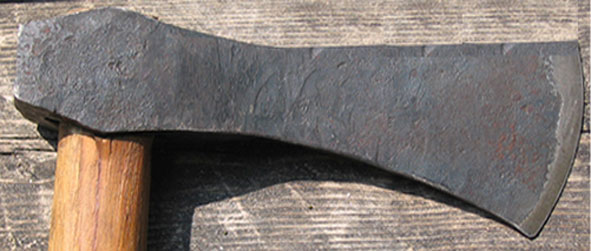
Figure 7 : Prototype of a Peterson type K
Early in the investigations leading to T2T, a typical Peterson type
K axe had been created (at the Wareham Forge, again in mild steel,
using traditional blacksmith’s equipment), with a thin ‘fine
trimming’ edge. Set on a 60 cm long handle, it was clear to any
experienced tool user that this axe could be easily controlled to
take thin cuts off wooden beams, as for building construction or
shaping ship timbers. (Although it was also equally clear that if
used in combat it’s ease of handling would prove extremely
effective!)
In all artifact examples (regardless of origin) the body of the axes
were forged from a block of bloomery iron, either with or without an
added hard ‘steel’ cutting edge. With corrosion, the distinctive
gain lines natural to this material often indicate the exact forging
steps undertaken in forming any axe.
Again as comparison, Viking Age axes use several forging methods:
Eyes may be made by : - slitting and drifting open,
- slitting the peen end and
then wrapping to the rear and welding
- folding towards the front
and welding
Edges may be made by : - using the source iron only
- adding a lap welded steel
edge to one side
- adding an inset and welded
steel edge
For T2T a prototype replica was made of the Rhynie Axe, taking the
discussion above into consideration.
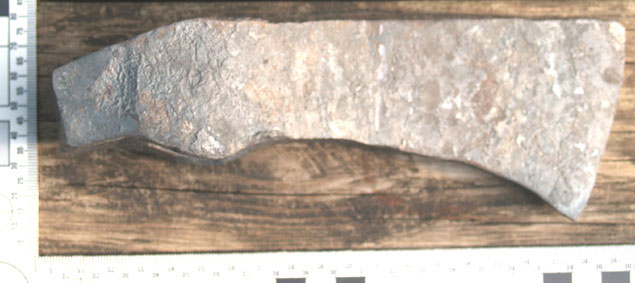 figure 8 : Prototype of the Axe - about life sized
figure 8 : Prototype of the Axe - about life sized
Rough forged weight = 1005 gm
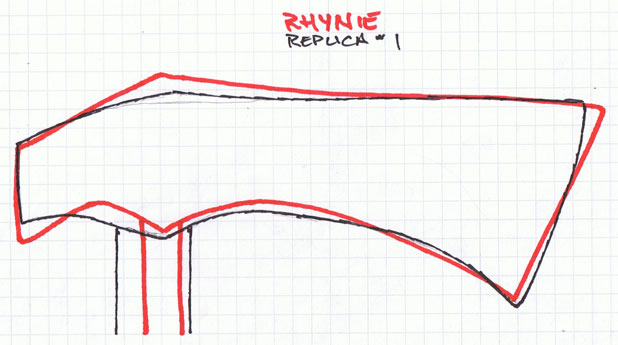 figure 9 : Comparing the replica to the carving as profiles,
life size.
figure 9 : Comparing the replica to the carving as profiles,
life size.
It can be seen that the rough forging is fairly close to the Rhynie
profile. For the replica, the eye was slit and drifted open. This
process is the easiest way to retain the quite heavy peen indicated
in the source illustration. The eye was sized to allow mounting to a
standard modern sledge hammer handle for ease of presentation (the
size used may effect the overall result). It can be seen (figure 10)
that the starting slit for the eye was made a bit too long, this
primarily a function of the available tools.
The replica was forged from a block of modern mild steel, at the
Wareham Forge, again using a ‘traditional’ bituminous coal forge and
large (225 lb) anvil. (4) The work was assisted by use of a small
industrial air hammer (which can induce certain shapes in process).
No additional hard steel edge was welded on. The finished head was
again not polished or sharpened.
The primary difference between this replica and the historic
illustration lies in the degree of the upset bottom edge of the
peen. The exact shaping around the eye wings and this peen edge
likely could have been duplicated more exactly through some final
hand forging. (After three hours of heavy work, it was decided to
stop before human error was likely!)
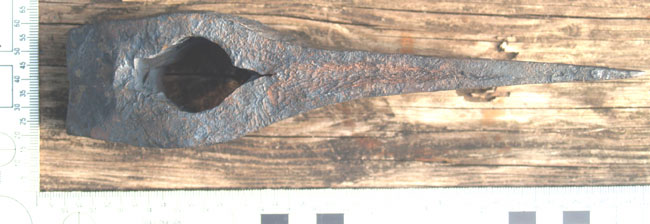 figure 10 : Prototype axe of mild steel - top view, life size
figure 10 : Prototype axe of mild steel - top view, life size
Without knowing the exact cross section of Rhynie, it is hard to
estimate possible head weight. If Rhynie had a simple 'wedge' form
(such as seen in Sutton Hoo) the estimated volume is roughly 160 cc,
producing a head weight in the range of 1200 + gms. This would place
Rhynie at roughly double the head weight of Sutton Hoo.
This however, is not considered the most likely cross section
however. The replica blade was shaped as a 'fine tool' cross
section. This reduces the overall weight, as a rough forging, to
1005 gm. It can be seen that the thickness of the peen is close to
that at the eye, placing much of the mass to that end of the centre
line of the handle. This overall shape results in a more balanced
distribution of weight, increasing control of the cutting edge in
actual use. The end result is a cutting tool that can be effectively
controlled (with considerable precision) even when used in a single
hand. (In contrast, axes with the simple wedge profile will 'hit
harder', but at the cost of being considerably more difficult to
control in flight.)
Although the original intent of the T2T project was to proceed from
bloom to working bar into object in Scotland, a combination of
equipment problems and available materials made this too difficult.
At the start, SSW did not have anything more than the most basic
blacksmithing equipment :
- a good sized antique anvil, but poorly mounted
- a portable ‘dish’ style forge, but in poor
repair
- no working blacksmithing hammers (although new
ones were purchased for T2T)
- a random selection of tongs, almost all too
large sized for the work involved
The huge problem turned out to be fuel. What was sold locally as
‘Smitty Nuggets’ blacksmith’s coal was the highest sulphur content
coal I ever experienced (in over 40 years of blacksmithing). Even
working out of doors, the volume of toxic smoke produced was
absolutely unacceptable. Sulphur is also a contaminant that
adversely effects forge welding ability, one of the main processes
required in compacting and purifying raw blooms into bars. Primarily
for these reasons, creation of a replica Rhynie Axe from the blooms
previously made was postponed to Phase 3, August to September 2023.
Creating the Bloomery Iron Replica :
As discussed above, the estimated weight of the Rhynie Man axe is
about 1000 gms as a rough forging. As already detailed, several
sections of the blooms created during Phase 2 where retained to be
further worked on at the Wareham Forge in Ontario. Using a simple
grinder spark test, the bloom from 2.1was found to contain virtually
no carbon, from 2.3 estimated at 0.2 – 0.3 % carbon. The combined
weight of the bloom pieces from Smelt 2.1 and 2.3 was 2042 gms, as
the starting blocks reduced to 1172 gm. These bars were further
forged to better match the pieces needed to combine into a rough
starting blank. There was additional (minor) loss, due to the
typical flaking off of hammer scale during this process. The two
plates from 2.1 were adjusted in dimension and one cut to match, the
2.3 bar cut into a small block for the peen and the other end forged
into a wide wedge for the cutting edge insert. The total weight at
preparation for the final welding up was 911 gm, with 118 gm
remaining unused.
The method chosen required two major hammer welding steps, first at
the peen end, second from the edge back towards the body, this
leaving a gap that would later be expanded to form the eye.
The finished replica was obviously somewhat smaller than the layout
estimate, a rough forging of 739 gm, a loss during welding and
forging to shape of a further 18% of the starting pieces. There
would be further reduction expected if the axe was polished to
‘bright’ and completed to a sharp cutting edge. (Appendix C :
Forging the Axe)

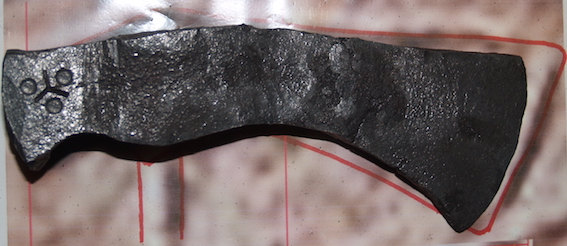
figures 11 & 12: Completed bloomery iron replica, top
and right side view (with maker’s mark), placed over
carving illustration.
In estimating the exact details of the Rhynie Man Axe, a reasonable
balance needs to be made between what is most certainly artistic
license by the original carver against a possible depiction of exact
reality. There remains the problem that there are very few existing
artifact axes to draw parallels from, and it appears none at all
from contemporary Pictish sources.
The use of the Sutton Hoo axe-hammer is suggested as not a reliable
prototype, as its design is reflected in its quite distinctive
intended function. It would appear that the primary reason for use
of this artifact source is because of the single line handle in the
Rhynie carving.
Expanding the potential artifact examples to include roughly
contemporary Viking Age axes, of which there are certainly a great
number, is strongly suggested here. The best 'fit' appears to be the
Peterson Type K axe (admittedly, Norwegian and some 200 years
later), plus numerous examples seen in Denmark. Combining these
examples with actual forging methods, with a consideration of
experience in actually handling axes of various types, does suggest
this a 'most likely' prototype design.
The Rhynie Man Axe is thus considered a 'fine tool' type, roughly
1000 gm in head weight. It may have had either a slit and drifted
eye, or an eye formed by slitting and welding the peen end, possibly
a peen enlarged by welding in an additional block. It is not
possible to tell if the blade would have had an inset carbon steel
edge, but this is likely considering 'best possible' tool making
practice. The high status attributed to the Rhynie Man certainly
would demand this quality. Of course the actual angle of the cutting
edge best determines potential use, and this remains quite unknown
from the reference carving. Such a head, fitted with a wooden handle
in the 60 - 80 cm long range, would produce an object easy enough to
control with a single hand, but also producing considerable power if
swung with two. It easily could have been a dual purpose tool or
weapon, able to create fine shaping cuts in wood - or devastating
power in battle.
Although the intent of Phase 2 was to devote several working days to
the second stage process, bloom to bar, followed by the third stage,
bar to object, this in the end did not prove possible. After several
quite unsatisfactory tests, and considerable outside consultation,
it was found that the 'best' available coal was in fact imported
from Poland. This itself was a major surprise, and certainly
reflects directly back to the framing concept of human impact on
natural resources, a process certainly much more dramatic in our
current age.
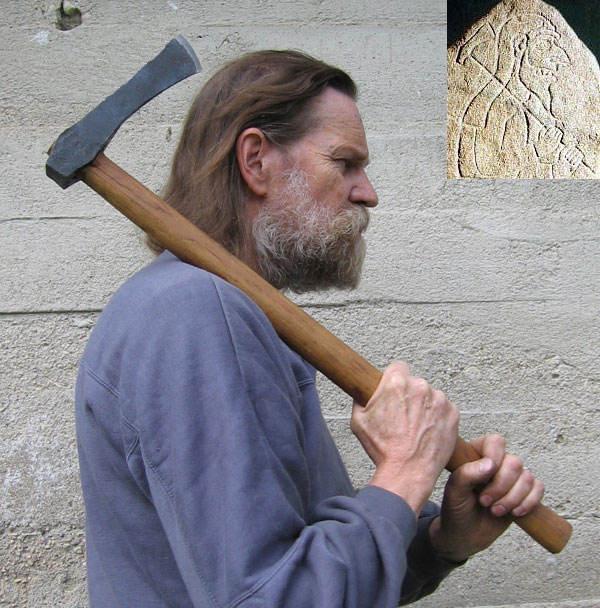 figure 13 : Posing as the Rhynie Man in 2014 (d)
figure 13 : Posing as the Rhynie Man in 2014 (d)
The axe used here is the Early Viking Age replica discussed
above.
The handle length is 66 cm.
Image Credits :
Note : In preparing this report, much use was made of modifying
images via Photoshop to alter scale and proportion. Available
images were re-sized to life to allow for more consistent
measurements and to serve as a close comparison during the making
process. Apologies are given for the poor quality resulting from
this method. Certainly considerable care must be taken with this
kind of data generation method. (Obviously first hand examination
of actual artifacts would be ideal, but in this case was not
physically possible.)
a) Unknown / Visit Aberdeenshire, (date?), ‘The Rhynie Man,
Aberdeenshire Scotland’, (web page), used without permission :
https://www.visitabdn.com/listing/the-rhynie-man
b) Angela Care Evens (?) 1986, ‘The Sutton Hoo Ship Burial’,
pg 42 (modified), used without permission
(A portion of the original excavation report, by Rupert
Bruce-Mitford, was also available as a reference here.)
c) Petersen, J., 1919, ‘De Norske Vikingesverd’, via internet
source (direct download of portion of document scanned as pdf), used
without permission
d) Kelly Probyn-Smith, 2014, used with permission
Footnotes :
1) A traditional measurement, ‘one hand’ (commonly used to measure
the shoulder height of horses) was considered to be 4 inches = 10
cm.
2) “ The francisca (or francesca) was a throwing axe used as a
weapon during the Early Middle Ages by the Franks, among whom it was
a characteristic national weapon at the time of the Merovingians
(about 500 to 750 AD). It is known to have been used during the
reign of Charlemagne (768–814). Although generally associated with
the Franks, it was also used by other Germanic peoples of the
period, including the Anglo-Saxons; several examples have been found
in England ” (Wikipedia, ND)
3) Initial estimates were generated by making modelling clay
replicas, then determining the volume and multiplying by density.
Historic wrought iron will be somewhat less dense than pure iron (at
7.87 gm/cc), so a multiple of 7.8 gm/cc has been used. ( Data from
‘The Material Property Database’ : www.matweb.com
)
4) It is worth remembering that the ancient blacksmiths who made the
artifacts would have been working on small iron anvils, generally in
the range 10 cm on a side (from a single bloom) or even flat block
of stone. Forges would have been ground mounted and fired charcoal,
which would be more difficult to generate high welding temperatures
over large objects like axe heads.
References :
Evens, A. C., 1989, ‘The Sutton Hoo Ship Burial’, British
Museum Publications, London UK
Härke, H., 2010, ‘Weapons: axe, swords, spears, shields. The
weapon burial rite at Blacknall Field’, in ‘The Anglo-Saxon
cemetery of Blacknall Field, Pewsey, Wiltshire'
(Wiltshire Archaeological and Natural History Society Monograph No.
4), Annable, F.K. & Eagles, B. N., pg 7-17, (internet
sohttp://forum.blankvaapen.org/showthread.php?t=744urce) last
accessed 7/24/23 : www.academia.edu/1178534/
Markewitz, D., 2008, 'Exploring the Viking Age in Denmark', CD-ROM,
The Wareham Forge, Canada
Petersen, J., 1919, ‘De Norske Vikingesverd’ via internet
source (direct download of portion of document scanned as pdf) : http://forum.blankvaapen.org/showthread.php?t=744
Wikipedia (unknown), ND, ‘Francisca’ (web site) last accessed
7/24/23 : https://en.wikipedia.org/wiki/Francisca
(unknown), 2016, ‘From Turf to Tools’ , in SSW News (blog
post) last accessed 7/20/23 : https://scottishsculptureworkshop.wordpress.com/projects/from-turf-to-tools/
